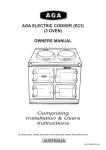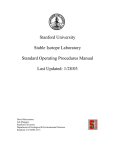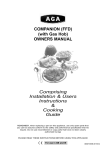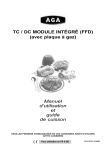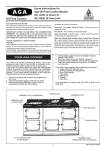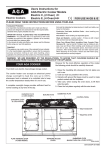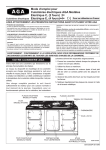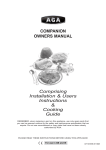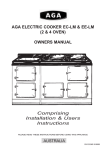Download AGA TC MODULE (FFD)(with Gas Hob) Specifications
Transcript
TC/DC INTEGRATED MODULE (FFD) (with Gas Hob) Cooking Guide included inside Users Instructions & Cooking Guide PLEASE READ THESE INSTRUCTIONS BEFORE USING THIS APPLIANCE For use in GB and IE 01/15 EOPI 516394 CONTENTS SECTION PAGE INTRODUCTION 3 HEALTH & SAFETY 4 CONTROL PANEL 6 GAS HOTPLATE 7 THE GRILL AND THE OVENS 8 OVEN COOKING GUIDE 9-13 CLEANING & CARING FOR YOUR COOKER 14-16 SERVICING 17 2 INTRODUCTION As responsible manufacturers we take care to make sure that our products are designed and constructed to meet the required safety standards when properly installed and used. IMPORTANT NOTICE: PLEASE READ THE ACCOMPANYING WARRANTY. Any alteration that is not approved by AGA could invalidate the approval of the appliance, operation of the warranty and could affect your statutory rights. In the interests of safety and effective use, please read the following before using your new AGA appliance. The use of a gas cooking appliance results in the production of heat and moisture in the room in which it is installed. Ensure that the kitchen is well ventilated, keep natural ventilation holes open or install a mechanical ventilation device (mechanical extractor hood). Prolonged intensive use of the appliance, may call for additional ventilation, for example, opening of a window, or more effective ventilation, for example increasing the level of mechanical ventilation where present. Installation must be to local and National wiring regulations and carried out by a Qualified Engineer, from an authorised distributor. A little smoke and some odour may be emitted when first switched on. This is normal and harmless (from oven lagging and starch binder on the element insulation) and will cease after a short period of use. The AGA TC/DC Integrated Module with Gas Hob, has been designed to compliment your AGA Total Control. Retaining the external AGA image of durable enamel cast iron. The appliance ‘looks at home’ adjacent to its well known ‘parent’. At the same time giving a flexible alternative during for instance the warm summer months when you may wish to turn off your main AGA cooker. Your appliance has a gas hob, electric grill and two electric ovens. The upper oven is an electric conventional oven with traditional zoned heating, an electric grill is also incorporated in the roof of the oven. The appliance is fitted with a cooling fan, which functions during the use of the grill or top oven (occassionally with the lower oven). The fan will continue to run after the grill/lower oven has been turned off or until the unit has sufficiently cooled. The lower oven has an electric fan. The fan behind the rear panel ensures an even distribution of heat within the cavity during cooking, ie temperature at lowest shelf position is the same as the temperature at the highest shelf position. Refer to the diagram (See Fig. 1) to familiarise yourself with the product and refer to the relevant sections for upper oven, lower oven, grill, gas hotplate etc. Your Module is supplied with the following accessories: 3 1 1 1 Grid shelves, one of which is used as a grill shelf Large grill pan and grid - (FOR USE IN THE UPPER OVEN ONLY) Roasting tin Baking tray The following loose parts, are also packed with the appliance:2 4 4 1 twin pan supports hotplate burner heads hotplate burner caps burner ring (wok burner) 3 HEALTH & SAFETY APPLIANCE YOUNG CHILDREN SHOULD BE KEPT AWAY FROM THE APPLIANCE AS SURFACES CAN BECOME HOT TO THE TOUCH. This appliance may contain some of the materials that are indicated below. It is the Users/Installers responsibility to ensure that the necessary personal protective clothing is worn when handling where applicable, the pertinent parts that contain any of the listed materials that could be interpreted as being injurious to health and safety, see below for information. Glues and Sealants Exercise caution - if these are still in liquid form use face mask and disposable gloves. Glass Yarn, Mineral Wool, Insulation Pads, Ceramic Fibre May be harmful if inhaled. May be irritating to skin, eyes, nose and throat. When handling avoid contact with skin or eyes. Use disposable gloves, face masks and eye protection. After handling wash hands and other exposed parts. When disposing of the product, reduce dust with water spray, ensure parts are securely wrapped. General l IMPORTANT: Oil is a fire risk, do not leave pans containing oil unattended. l In the event of a fire cover with a lid and turn OFF the appliance. Smother the flames on the hob preferably with a fire blanket, rather than attempting to remove the pan to the outside. Burns and injuries are caused almost invariably by picking up the burning pan to carry outside. Deep Fat Frying l Use a deep pan, large enough to completely cover the appropriate heating area. l Never fill the pan more than one-third full of fat or oil. l Never leave oil or fat unattended during the heating or cooking period. 4 SEMI RAPID BURNER RAPID BURNER GAS HOTPLATE WOK BURNER SEMI RAPID BURNER CONTROL PANEL GRILL PAN WITH GRID GRID SHELF GRILL & CONVENTIONAL OVEN GRID SHELF FANNED OVEN ROASTING TIN (BAKING TRAY NOT SHOWN) FOR USE IN BOTH OVENS DESN 511635 C Fig 1 5 CONTROL PANEL GAS HOB BURNERS REAR LEFT FRONT LEFT REAR RIGHT FRONT RIGHT GRILL TOP OVEN LOWER OVEN TOP OVEN NEON LOWER OVEN NEON DESN 515698 A Fig. 2 l The GAS HOTPLATE CONTROL KNOBS can only be rotated anti-clockwise from the OFF position. Large Flame Symbol - High Setting Small Flame Symbol - Low Setting (See ‘HOTPLATE’ section). l The GRILL ELEMENT KNOB can be rotated in any direction. Clockwise Full on with, both elements on (graduated line with full circle). Anti-clockwise Economy grill, front elements only l The OVEN KNOBS can only be rotated clockwise from the OFF position. l The OVEN NEONS illuminate when ovens are switched on. When the temperature required is reached the neon will extinguish. 6 GAS HOTPLATE l The hotplate has four gas burners. rear left - rapid burner - rated at 3.0 kW. front left and rear right - semi rapid burners - each rated at 1.75 kW. front right - ultra rapid (wok) burner - rated at 3.5 kW. l The semi rapid burners are especially suited for use with small pans and for gentle simmering or poaching. l All burners have a set simmer position and are easily adjustable. TO USE THE HOTPLATE l To light a hotplate burner: push in and turn the control knob anti-clockwise to the large flame symbol ( ), and hold in for 3 seconds until the burner lights, then turn the knob to the required setting. l If the burner flame should accidentally go out, turn off the burner control and do not attempt to re-light the burner for at least one minute. l The control may be set towards a lower position, simply by turning the control knob towards the small flame symbol. l IMPORTANT: The cast iron pan supports on the appliance are much heavier than those on most gas hotplate cookers, therefore care must be taken when removing or re-fitting them to the hob, It is important that they are lifted from the appliance and not dragged across nearby enamelled parts which would result in damaging the enamel. SOME SAFETY POINTS l Simmering aids such as asbestos or mesh mats are not recommended. They may impede burner performance, damage the pan supports and waste fuel. l Commercially available foil spillage aids are unnecessary on this cooker. l Some ‘Wok’ cooking pans are unstable. Check with the ‘Wok’ manufacturer before purchasing. l DO NOT USE unstable and misshapen pans (e.g. with convex bases) that tilt easily. l The minimum pan diameter recommended is 120mm. Maximum recommended is 280mm. l Never use pans which overhang the front facia. l Place all pans centrally over the burners. l Always position pan handles away from the front of the cooker - away from the reach of small children. l NEVER leave a chip pan unattended. l Pans and kettles with concave bases should not be used. 7 THE GRILL (TOP OVEN) l THE TOP OVEN DOOR MUST BE KEPT OPEN WHEN THE GRILL IS ON. l CAUTION: Accessible parts may be hot when the grill is in use. Young children should be kept away. l The grill has graduated heat settings on each of the 2 elements (see control panel). l For best results pre-heat at a high setting. l The large grill pan supplied will fit on any of the three shelf positions. l Most foods should be cooked on the grill grid in the grill pan. You can turn the grid over to suit different thicknesses of food. You can place some dishes straight onto the oven shelf this is useful when browning the top of food such as cauliflower cheese. l This cooker is supplied with one grid/grill shelf for the top oven. THE OVENS General l The shelves are designed to be non-tilt. l To remove a shelf lift clear of the side notches and slide forward. To replace a shelf insert into the oven with the short prongs at the rear, facing upwards. Slide into position above the side notches then allow to drop down on the runner. l Do not place the grid shelf or food on the bases of the ovens. Food will burn on the base of the top oven and air circulation will be affected in the lower oven. l Pre-heat the ovens at the appropriate settings until the neon light goes out. l When cooking in both ovens at the same time you may need to reduce the temperature and cooking times (especially for baked foods). l For effective heat distribution, leave a gap of no less than 12mm between the dishes and the sides of the oven, to allow hot air to circulate. l The large grill pan and grid are not designed to fit the lower oven. l If you also have an AGA DO NOT use the small roasting tin provided with the AGA in the Module. Please use utensils provided and place on the grid shelves. Condensation Condensation may form on the cooker. This is quite normal and nothing to worry about. The condensation forms when heat and moisture are present, for example during cooking. Whenever possible try to make sure that the food which contains a lot of moisture for example casseroles are covered. If you do notice any condensation, wipe it up straight away. 8 OVEN COOKING GUIDE Cooking Hints l Both ovens must be pre-heated until the light extinguishes. l The guidelines are for cooking after the oven (s) have reached the desired temperature. l Larger items may benefit from being turned. l Shelf positions are counted from the top. l Put dishes in the centre of the shelf. l When using both ovens together reduce cooking times and settings. l It is important to check that food is piping hot before serving. l You can change the settings and cooking times to suit your tastes. Deep Fat Frying l Do not try to fry too much food at a time, especially frozen food. This only lowers the temperature of the oil or fat too much, resulting in greasy food. l Always dry food thoroughly before frying, and lower it slowly into the hot oil or fat. Frozen foods in particular, will cause frothing or spitting, if added too quickly. l Never heat fat, or fry with a lid on the pan. l Keep the outside of the pan, clean and free from streaks of oil or fat. l The following charts give a guide to cooking a number of every day items. 9 Top Oven (Conventional) Top Oven (Conventional) • Top Oven (Conventional) • Top Oven (Conventional) l The cooking charts are a general guide but times and temperatures may vary according to individual recipes. l The meat sections should be used as a guide but may vary according to the size, shape of joint on or off the bone. l Thaw frozen joints thoroughly before cooking them. l The times are for open roasting. If covered with foil allow extra time. l The turkey/chicken is cooked when the juices run clear when pierced with a skewer. If the juices are still pink continue to cook checking every 15 minutes until juices run clear. l 1kg = 2.2Ib SETTING °C SHELF POSITION 180 3 Rare 35 mins per kg plus 20 mins 180 3 Medium 45 mins per kg plus 25 mins 180 3 Well Done 55 mins per kg plus 30 mins Lamb 180-190 3 Well Done 55 mins per kg plus 25 mins Pork 180-190 3 Well Done 1 hr 5 mins per kg plus 30 mins 190-200 3 Large 220 3 25 - 40 mins Individual 220 3 15 - 25 mins FOOD APPROXIMATE COOKING TIME Roasting meat Beef Poultry Chicken 45 mins per kg plus 20 mins Yorkshire Pudding 10 Top Oven (Conventional) • Top Oven (Conventional) • Top Oven (Conventional) • Top Oven (Conventional) • Top Oven (Conventional) SETTING °C SHELF POSITION 150 2 45 mins - 1 hr Very Rich Fruit Cake 130 - 140 3 3 - 4 hrs Fruit Cake 150 - 160 3 1 - 2 hrs Small Cakes 190 3 15 - 25 mins Scones 220 3 10 - 20 mins Victoria Sandwich 180 3 20 - 35 mins Swiss Roll 210 2 10 mins 180 - 190 2 10 - 15 mins 180 3 30 - 35 mins Plate Tarts 200 2 25 - 35 mins Fruit Pie 200 3 35 - 45 mins Mince Pies 200 2 20 - 25 mins Vol-Au-Vents (frozen flaky) 220 3 15 - 20 mins 210 - 220 2 20 - 25 mins depending on size Milk Puddings 150 - 160 3 2 hrs approx. Baked Sponges 170 - 180 3 45 - 55 mins Baked Custards 150 3 45 - 55 mins Meringues 100 3 1.5 - 3 hrs depending on size Apple Crumble 180 3 30 - 40 mins Bread 220 3 30 - 40 mins Rolls and Buns 220 3 10 - 20 mins FOOD APPROXIMATE COOKING TIME Cakes and Biscuits Shortbread Biscuits Tray Bakes Pastries Eclairs/Profiteroles Puddings Yeast Mixtures 11 Lower Oven (Fanned) Lower Oven (Fanned) • Lower Oven (Fanned) • Lower Oven (Fanned) l The lower oven is a fan oven, which means the air is circulated to create an even temperature throughout the oven. In most cases this means that food requires a lower temperature when cooked in this oven, by approximately 1020ºC. Also some baked goods may require a slightly reduced cooking time by a few minutes. l The cooking charts are a general guide but times and temperatures may vary according to individual recipes. l The meat sections should be used as a guide but may vary according to the size, shape of joint on or off the bone. l Thaw frozen joints thoroughly before cooking them. l The times are for open roasting. If covered with foil allow for extra time.. l The turkey/chicken is cooked when the juices run clear when pierced with a skewer. If the juices are still pink continue to cook checking every 15 minutes until juices run clear. l 1kg = 2.2Ib SETTING °C SHELF POSITION 170 2 or 3 Rare 35 mins per kg plus 15 mins 170 2 or 3 Medium 45 mins per kg plus 20 mins 170 2 or 3 Well Done 55 mins per kg plus 30 mins Lamb 170 - 180 2 or 3 Well Done 55 mins per kg plus 20 mins Pork 170 - 180 2 or 3 Well Done 1hr 5 mins per kg plus 30 mins 180 - 190 2 or 3 170 3 FOOD APPROXIMATE COOKING TIME Roasting meat Beef Poultry Chicken Turkey 45 mins per kg plus 15 mins Up to 4kg 40 mins per kg plus 10 mins Over 4kg 30 mins per kg plus 20 mins Yorkshire Pudding Large 190 - 200 Any 25 - 40 mins Individual 190 - 200 Any 15 - 25 mins 12 Lower Oven (Fanned) • Lower Oven (Fanned) Lower Oven (Fanned) • Lower Oven (Fanned) • Lower Oven (Fanned) SETTING °C SHELF POSITION 140 2 or 3 45 - 50 mins Very Rich Fruit Cake 120 - 130 3 3 - 4 hrs Fruit Cake 140 - 150 3 1 - 2 hrs Small Cakes 180 Any 15 - 25 mins Scones 200 Any 8 - 12 mins Victoria Sandwich 170 Any 20 - 35 mins Swiss Roll 200 2 10 mins 170 - 180 Any 10 - 15 mins 170 3 25 - 30 mins Plate Tart 190 2 or 3 25 - 35 mins Fruit Pie 190 2 or 3 25 - 45 mins Mince Pies 190 1&3 20 - 25 mins Vol-Au-Vents (frozen flaky) 210 1&3 15 - 20 mins Eclairs/Profiteroles 200 2 20 - 25 mins depending on size 140 Any 2 hrs approx. Baked Sponges 160 - 170 2 or 3 45 - 60 mins Baked Custards 140 2 or 3 45 - 55 mins Meringues 90 2 or 3 1.5 - 3 hrs depending on size Apple Crumble 170 3 30 - 40 mins Bread 200 2 or 3 25 - 35 mins Rolls and Buns 200 2 or 3 10 - 20 mins Cheese Souffle (Individual) 190 3 20 - 25 mins Cheese Souffle (Large) 190 3 25 - 35 mins FOOD APPROXIMATE COOKING TIME Cakes and Biscuits Shortbread Biscuits Tray Bakes Pastries Puddings Milk Puddings Yeast Mixtures Souffle 13 CLEANING & CARING FOR YOUR COOKER l Always switch OFF at mains before cleaning. l When cleaning use as little water as possible. l Do not use abrasive pads, oven cleaner, or cleaners containing citric acid on enamelled surfaces. l Do not use a steam cleaner to clean this cooker. Surfaces that require cleaning are: Enamelled Top and Front Plate l The easiest way to clean the AGA top plate and front plate is to mop up spills as they happen. l Baked on food is more difficult to clean but can usually be removed with proprietary vitreous enamel cleaners or mild cream cleaners using a cloth, or if necessary, a nylon scouring pad. l If milk or fruit juice, or anything containing acid is spilt on the enamel. wipe off immediately. l Clean off any condensation streaks on the front plate around the oven doors or the vitreous enamel may be permanently discoloured. l All that is usually needed to keep the vitreous enamelled surfaces of your cooker bright and clean is a daily rub over with a damp cloth followed immediately with a clean, dry cloth to avoid streaks. l Remember the top plate will scratch if pans or utensils are dragged across them. Gas Hotplate l If spillage does occur on a burner cap or pan support, move pan to another burner and when cool, clean in hot soapy water. l After cleaning, be sure all parts are dry. When fitting the burner cap and burner head, make sure that the hole in the burner head is correctly located over the ignition electrode (See Fig. 3a, 3b, 3c), and that the burner cap is sitting correctly on the burner head. l The ignition electrode must not be displaced or damaged otherwise spark ignition will be affected. l The hotplate top is sealed. To clean, remove pan supports and wipe over visible surface. l PLEASE NOTE: The following loose parts MUST NOT be cleaned in a dishwasher, as this could damage or discolour the finish:- pan supports, burner caps, burner ring and burner head. l Aluminium pans may cause metallic marking on the pan supports. This will not affect the durability of the enamel. NOTE: The appliance guarantee does not cover the mis-use of the pan supports. The Ovens l The fan oven has a back panel which is finished with self cleaning enamel and should not be scoured. l The shelves can be removed and if necessary the shelf supports may also be removed by taking out the screws. l These items may be washed in the sink with normal oven cleaners, you may use a fine wool soap pad for removing stubborn stains from the oven bases and shelf supports. l NOTE: TAKE CARE NOT TO DAMAGE THE THERMOSTAT PHIALS IN THE OVENS WHEN CLEANING. 14 Heat-Clean Enamel l Fan Oven – Back panel only This special enamel has a continous cleaning action, which works best if a pattern of low and high temperature cooking is followed. By using low temperature roasting, excessive fat splashes can be avoided. Should any excessive staining occur, immediately clean the area with hot water containing detergent, and a nylon washing-up brush. Resistant stains require the oven to be run at 210ºC for 2 hours. Do not use any cleaning material which may clog the pores of the special coating e.g. pastes and powders, soap-filled pads, wire wool, spray cleaners, brush-on cleaners, caustic solutions, metal scrapers/knives, and prevent the continuous cleaning action. Door Liners l May be cleaned with a cream cleaner or soap impregnated pad. l DO NOT, however, immerse the doors in water as they are packed with insulating material which will be damaged by excessive moisture. Controls l The enamelled surfaces under the knobs can be treated as in the section ‘Door Liners’. Avoid the use of excessive water. l DO NOT use oven cleaners, scouring pads and abrasive powder for cleaning plastic knobs. A wipe with a damp cloth should be sufficient. Important Note: AGA recommend Vitreous Enamel Association approved cleaners for cleaning the vitreous enamel surfaces of this product. 15 BURNER CAP RETAINING LUGS Fig 3A DESN 511617 Fig. 3B DESN 513513 Fig. 3C DESN 513898 16 SERVICING l In the event of your appliance requiring maintenance, please contact your local authorised distributor. l Your cooker must only be serviced by a Qualified Engineer, from an authorised distributor. l Do not alter or modify the cooker. l Only the spares specified by the manufacturer, are to be fitted. 17 18 19 For further advice or information contact your local distributor/stockist With AGA Rangemaster’s policy of continuous product improvement, the Company reserves the right to change specifications and make modifications to the appliance described and illustrated at any time. Manufactured By AGA Rangemaster Station Road Ketley Telford Shropshire TF1 5AQ England www.agaliving.com www.agacookshop.co.uk 20




















